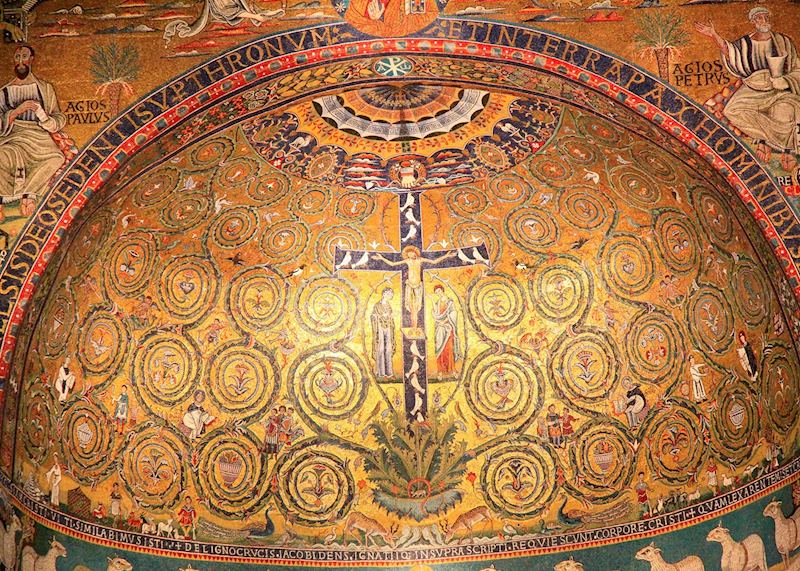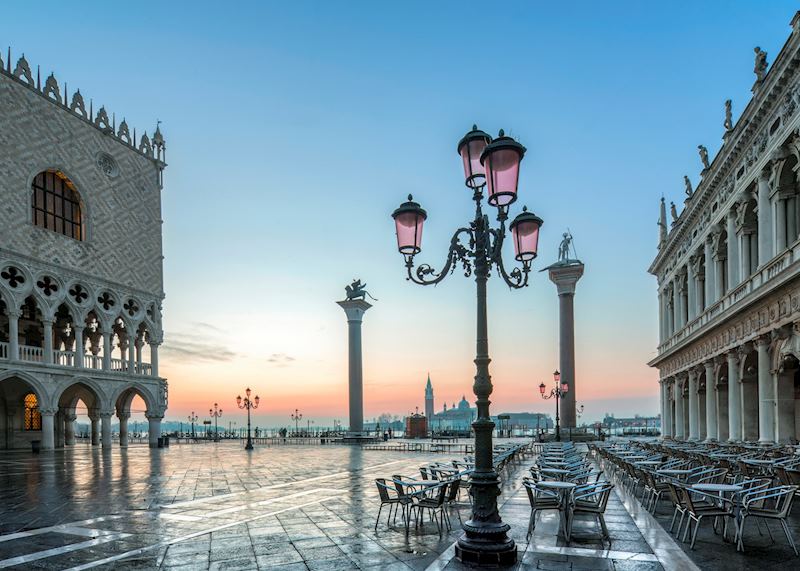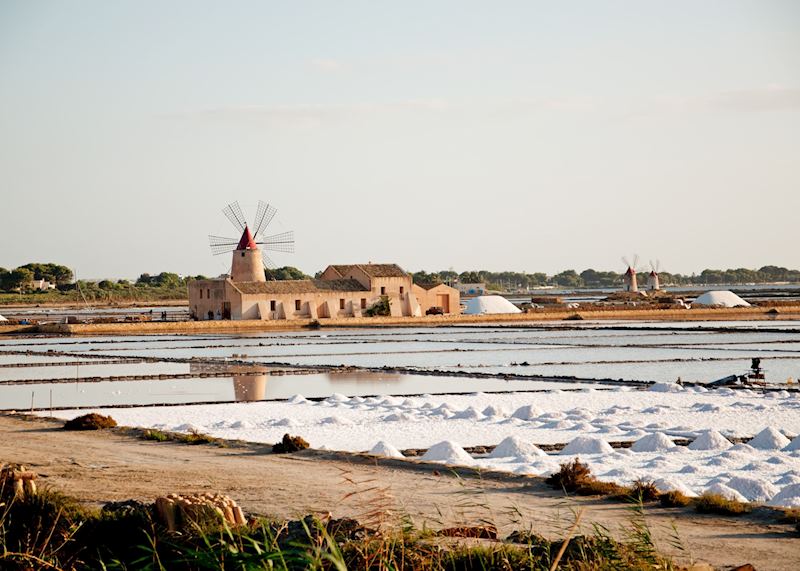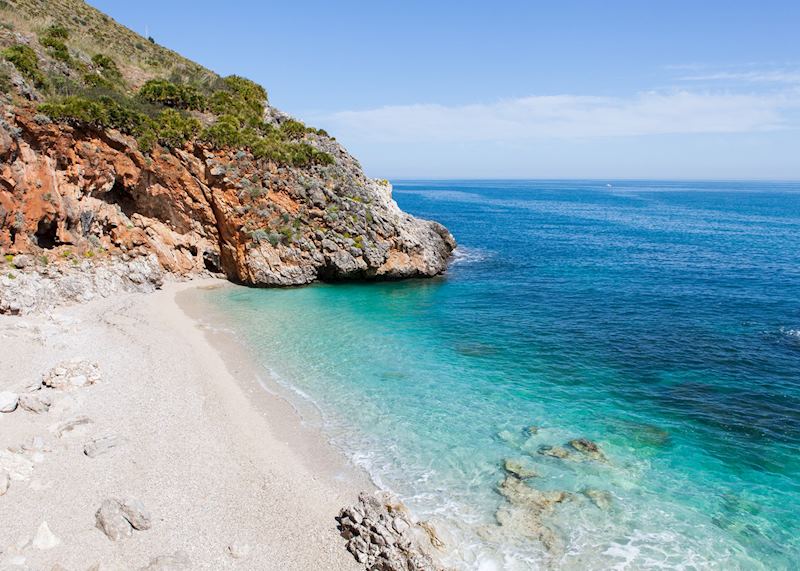A recent study of TikTok hashtag data has revealed which ten cities in Italy are the most popular with residents of the United States — Rome, Milan, and Venice top the list. Here, experts from across Audley Travel have come together to reveal their favorite hidden gems within each of the top ten. They’ve visited many times before and found the experiences that allow you to experience the authentic character of each city without getting lost in the crowds.
1. Rome’s hidden gems: Basilica of San Clemente
A major metropolis for more than 2,000 years, Rome has layers upon layers of history — literally. The city has been preserved, transformed, and expanded for millennia, and when you visit, you’re walking across the bones of the city’s many previous incarnations.
At the Basilica of San Clemente, you can see many of these layers revealed in one building. Often described as being three churches in one, San Clemente is a 12th-century basilica built on an incredibly well-preserved 4th-century church that, in turn, overlays a 3rd-century Temple of Mithras. A private tour through the centuries’ worth of construction offers a singular perspective on the city’s remarkable complexity and longevity.

2. Milan’s hidden gems: Biblioteca Ambrosiana & San Bernardino alle Ossa
The highlights in Milan are dazzling: the pink fairytale confection that is the Gothic cathedral, the Scala Opera House, da Vinci’s Last Supper, and, of course, some the best shopping on the continent. However, with a little effort, you can uncover remarkable treasures that most visitors overlook.
The Biblioteca Ambrosiana — usually translated as Ambrosian Library — is one of the oldest public libraries in the world. Built in the early 1600s, today it’s a scholarly treasure house that includes Leonardo da Vinci's Codex Atlanticus, a collection of 12 books that bind together the inventor’s writings and drawings. You can also see Caravaggio's Canestra di frutta, the artist’s first successful painting.
A short walk from the library is the San Bernardino alle Ossa, a church with a remarkable 13th-century ossuary. This small side chapel has a vault that’s decorated with a fresco called Triumph of Souls among Flying Angels, as well as mosaics made from the bones and skulls of condemned prisoners.

3. Venice’s hidden gems: secret passages in the Doge’s Palace & Venetian bars
Though it’s one of the most popular cities in the world, Venice still has quiet canals and hidden corners where few visitors go. We can arrange a tour through the secret passages in the Doge’s Palace — a twisty maze of passages where the public isn’t usually allowed. You’ll glimpse the interrogation room, see the prison cell that Casanova himself escaped from, and walk over the Bridge of Sighs, so named because it was the last look at the outside world many prisoners ever enjoyed.
You might also consider a guided tour of Venice’s bacari. These small, standing-room-only bars are tucked in along the city’s small back canals and popular with city residents. Stop for Venetian-style tapas — called cicchetti — and rub shoulders with the locals to get a taste of the city’s authentic atmosphere.

4. Naples’ hidden gems: Sanmartino's Veiled Christ
Naples earned its reputation as a boisterous city, jam-packed with vibrant street life and energetic population. Voices are loud, fish mongers sing, and the traffic is best described as chaotic. However, if you venture down a small side street and into the Cappella Sansevero, you’ll find one of the most solemn and transcendent statues in all of Europe, Cristo Velato (Veiled Christ).
Created by Giuseppe Sanmartino in the 1753, the statue is considered by some to rival Michelangelo’s David and the works of Bernini. The translucent veil seems fragile and ethereal, as if you could easily lift it away, rather than carved from marble. But the real artistry is the changeable expression on the figure’s face, sorrowful from some angles and deeply peaceful from others.
In the same chapel, you’ll also find Veiled Modesty, another tour de force of marble transformed into delicate drapery.

5. Florence’s hidden gems: master artisan tour
Often called ‘the powerhouse of the Renaissance’, Florence is well known for the number of master painters and sculptors who lived and worked in the city. However, the same wealth that provided patronage for big names like Michelangelo also fed a flourishing community of artisans, a community that still carries on traditional arts and crafts in the city to this day.
We can arrange a walking tour that will introduce you to some of the city’s remarkable craftspeople and give you a chance to see their wares. Highlights include a visit to a traditional cantucci shop to see how these quintessentially Tuscan biscuits are made, using a recipe dating back to the Renaissance. You’ll also stop at a mosaic workshop and a Tuscan leather studio, as well as a Tuscan enoteca (wine shop) to sample some local vintages, olive oils, and jams.

6. Trapani’s hidden gems: traditional salt pans
Once the heart of a powerful ocean-going trade network, the port city Trapani is still defined by its position on the westernmost edge of Sicily — even today, its major industries are fishing and shipping. Once upon a time, it was also a major source of salt for people around the Mediterranean, and salt from here is still considered the best in Italy.
To best understand the city’s history, you can take a guided tour of the city’s salt pans. Salt making here is a slow matter, and only a few artisanal producers still practice the traditional way, with shallow evaporation pools and wind power. Your tour will end with a leisurely seaside lunch under the slowly spinning blades of a restored windmill.

7. Como’s hidden gems: kayaking the lake
The city of Como, as well as the lake that shares its name, both draw people who come to soak up the natural beauty of the lake, mountains, and Alpine sunshine. However, we suggest a slightly different perspective — that from a kayak. Locally born guide Michele will lead you as you paddle past the most impressive sights on the lake, including Punta Spartivento, a point just off the Bellagio Peninsula that offers views of all three arms of the lake.
For another even more different look at the lake, consider an e-bike food tour through the waterside villages. The electric assist makes it easy to pedal over steep hills, stopping to sample the region’s food and wine along the way.

8. Bologna’s hidden gems: whispering galleries of Palazzo del Podestá
Architecturally, the university city of Bologna is known for its handsome buildings and colonnaded arcades, called portici, stretching from the heart of the city, Palazzo Maggiore. Located right on that plaza, the Palazzo del Podestá was originally designed for the city’s magistrate. Its double arcade and red-clay tiles fit right into the rest of the area. However, if you know where to look — or rather, where to listen — they hide a clever secret.
If you stand in the so-called ‘whisper galleries’, you’ll find that you can whisper to someone standing diagonally across the arcade from you. The architecture’s perfect acoustics will carry your voice perfectly, despite the distance. At the same time, even someone standing very close to you won’t be able to hear what you say. Local legend has it that this was one of the few places lepers could go to give confession.

9. Palermo’s hidden gems: Zingaro Nature Reserve
Culturally layered and joyfully chaotic, Palermo is one of the most interesting cities in Sicily and we suggest spending at least a few days there. However, if you need a calm break before plunging back into its ebullient streets, consider a hike at the nearby Zingaro Nature Reserve.
Just an hour to the west of the city, the reserve is usually very quiet — in fact, it’s possible that the only other person you’ll see is your guide. You can hike along well-maintained trails to soak up Sicily’s natural beauty, including turquoise water, grottoes, and rocky coves where, in warm weather, you might go swimming.

10. Verona’s hidden gems: Dante’s vineyard
Though it’s best known for its starring role in Shakespeare’s plays, Verona is set in some of Italy’s most beautiful wine-growing landscapes. Just a short drive from the city’s limits, you can explore a vineyard that has a literary connection of a different sort. Serego Alighieri was once owned by author Dante Alighieri and remained in his family for 21 generations — they still live on the grounds today.
You can visit this remarkable estate, as well as the home where Dante lived during his exile from Florence. You’ll walk through the grape vines, admire the orange groves, and sample three of the estate’s vintages.


